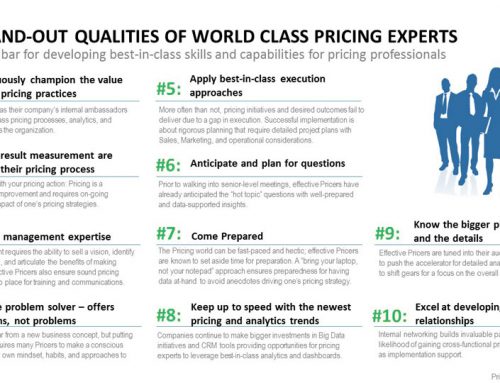by Paul Hunt – President
I was presenting at a conference recently and mentioned the Professional Pricing Society. A gentleman in the audience scoffed and could not believe there was such a thing!
Well, believe it or not, there actually is a Professional Pricing Society and it has been in existence for quite some time.
The PPS is in essence the global meeting place for all things related to pricing. It holds conferences in North America and Europe, conducts webinars, publishes a journal and a newsletter and has even developed a certification program through accredited courses; CPP (Certified Pricing Professional).
Just a couple of weeks ago I was at their fall conference in Las Vegas. There were more than 600 participants from a diverse range of industries and locations. The corporate names that attend are a who’s who of leading companies in their respective industries. What is surprising is that the participants are predominantly executives from the pricing profession whereas 20 years ago it was very rare for a company to have anyone with the pricing manager title.
So why has this new profession developed? I believe there are two core reasons:
- First, it is driven by the disproportionate impact pricing has on profitability; a 1% improvement in pricing leads to a 12.5% improvement for the bottom-line profitability of the average Fortune 500 business. A seminal article in the Harvard Business Review written in 1992 by a couple of authors from McKinsey related stories of tremendous improvements in profitability through successful pricing improvement. The article also shared tools and processes for driving pricing improvement. Once companies understood that they could systematically drive price performance the early adopters were hooked and jumped all over the opportunity. As the saying goes; “success begets success”.
- The other major development that has skyrocketed the growth of pricing as a discipline is technology. A company’s ability to track and organize their sales data has enabled them to systematically analyze and gain much better control over their “rogue” deals. It also allows a better understanding of the relationship between volume and price.
Furthermore, price elasticity was mostly a theoretical construct of economists that explained a lot but could not be applied in real life except in extreme cases such as commodities. Nowadays the research technique conjoint analysis enables many companies to accurately estimate the price elasticity for their products or services.
As a result of these factors, leading companies have invested heavily in Pricing Departments. One global Fortune 500 client of ours estimates that they have approximately 1,000 employees that are focused on pricing! What’s more, if you visit almost any Fortune 500 company you will undoubtedly find a pricing department led by a Pricing Director and a group of pricing analysts. As a matter of fact, one of the cutting edge trends right now is the elevation of Pricing to senior ranks. At the Las Vegas conference there were several Vice-Presidents of Pricing in attendance.
So what does all of this mean?
- If you have not established a pricing department then you are probably trailing your competition; not a good place to be.
- Companies see pricing as strategic and as such are elevating it to a senior role in the organization. If you do not have this vision, once again you are probably trailing your competition.
- There are associations and online clubs that are dedicated to pricing, if you have not heard of or joined one of them then guess what? You are probably trailing your competition.
In today’s hyper competitive environment you cannot afford to lag behind. I see a lot of companies that still haven’t gotten the complete picture when it comes to the development of this profession. So if you want to get started, you may want to consider attending the next pricing conference I am going to. It is next week in Barcelona! Nos vemos!


